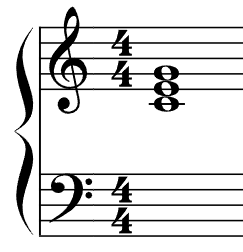
This is where you learn to build chords, and learn the fundamentals of their creation.
We know a chord is multiple stacked notes. At a minimum, two notes are required, and this two-note chord is called a dyad.
Three stacked notes make a triad. These sound fuller and more complete, typically.
So here’s how chords are created.
First, remember that chords are just intervals. An interval is a distance between two notes. So a chord is two or more notes with distance between the notes. Simple so far.
First rule: Each note in a triad should be three notes away from its neighboring note. This is also known as being a “third” away from a note.
That being said, you can’t just put any 3 notes together and call it a proper triad. It may be better to call a random group of 3 notes a “chord cluster.”
There are 5 main types of triads: Major, Minor, Diminished, Augmented, and Suspended. Each has a unique quality of sound. We will only look at the Major triad for now.
The Major Triad
This is a happy sounding chord. It is built using the 1st, 3rd, and 5th note of any scale. We are C Major here, so the notes for the first chord would be C, E, G.

Now, the first interval in that chord is C to E. The E is two steps away from the C. The interval is a total of 3 steps: C is the first step, E is the second step, and G is the third step. (We always count as “step 1” the first note we start on.)
The interval C to E determines the name and quality of the triad. So, we have a C major chord, C, E, G that looks like this:

We can continue to build chords using this same system, each new note we stack should be a third away. Here are all the chords in the C major scale. The root note is the first note on the bottom of each chord.

Now here’s something interesting.
In a chord, the first two notes of the stack are exactly two steps apart. This makes the dyad a major third. It’s in the major scale, so we name it “major” and the “third” part is because we’ve counted the steps — there are three steps, starting with C (and counting that as step one), then D, then E. Three notes. Three steps. Major Third.
Now the second interval, E to G, is only one-and-a-half steps, not two steps. This second interval is a minor third. Still three notes, from E to G… but not two steps.
We still call this a major chord, because the interval may be minor, but the chord is considered a major chord because the first interval, from C to E, is a major interval. Remember, it is the first interval of a chord that determines its name and type.
Finally, the first and last note of the triad are exactly five steps apart, making the first and last note a fifth when played as a chord.
